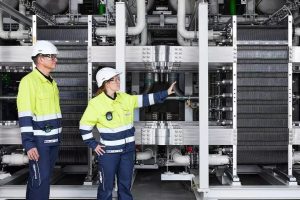According to FuelCell Energy, its electrolysis technology operates at about 90% electrical efficiency (HHV) and is capable of 100% electrical efficiency (HHV) when paired with available excess heat from industrial or nuclear facilities. The technology is under evaluation at the U.S. Department of Energy’s Idaho National Laboratory (INL), which is conducting stack tests to evaluate performance and durability.
“The stack has performed well across a broad range of conditions and unexpected events,” said Micah Casteel, Senior Research Mechanical Design Engineer at INL. “In addition to validation testing, our goal at INL is to push the boundaries of stack operation to find out how technology responds in non-optimal conditions to drive improvement. This technology has operated well, even in challenging test conditions.”
The new solid oxide platform is the result of more than 20 years of development and testing for applications such as hydrogen electrolysis, long-duration hydrogen energy storage, and power generation, and benefits from the decades of development and commercial production of FuelCell Energy’s carbonate power-generation platform.
As to its solid oxide fuel cell, the company highlights its ability to operate on a variety of fuels, including hydrogen, natural gas, and renewable biogas, its superior fuel efficiency relative to combustion-based power generation, and virtually zero NOx, SOx, and particulate matter emissions, among other things.
FuelCell Energy’s solid oxide operations are based in Calgary, Canada, and Danbury, Connecticut. The company is expanding its Calgary facility with the addition of a new, dedicated manufacturing space along with strategic hires to continue development and expand production. In parallel, the company is expanding its Connecticut manufacturing activities and evaluating U.S. locations in anticipation of increased production volume.







